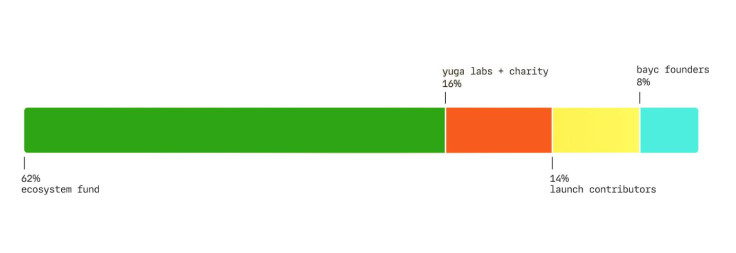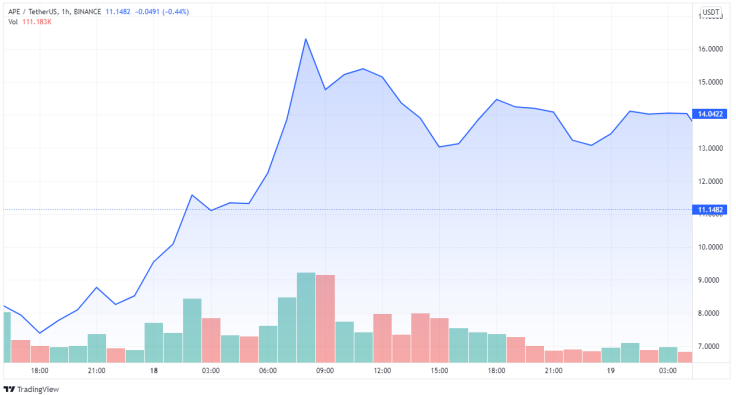What Is ApeCoin? A Look Into The Token Behind Bored Ape Yacht Club NFTs
Since the start of last year, art collectors, brands, investors, and crypto market participants have set their sights on Non-fungible tokens (NFTs). The transformational technology has now entered the mainstream.
Leading projects such as the Bored Ape Yacht Club (BAYC) have minted digital art collections sold for hundreds of thousands of dollars. The famous assortment of bored-looking apes has attracted the attention of numerous heavy hitters in entertainment, including Eminem, Snoop Dogg, Justin Bieber, and many more.
The hype surrounding the Bored Ape Yacht Club and its associated NFT collectibles gained more steam in March 2022 when the project launched ApeCoin (APE). The new cryptocurrency has grabbed headlines in recent weeks with its parabolic growth and promise to onboard thousands of users into the BAYC ecosystem.
Read on to learn more on the ongoing ApeCoin buzz and discover how the token backers plan to interconnect culture in Web 3.0 via digital artwork, gaming, and entertainment.
What is ApeCoin (APE)?

APE is the governance and utility token that serves the BAYC community and powers the entire NFT ecosystem. The token debuted on the crypto scene on March 17, 2022, and immediately became the latest sensation in the crypto world. The ApeCoin dev team quickly secured listings on major global exchanges like Coinbase, Kraken, Huobi, and Bybit, allowing crypto traders to follow and access the new token.
The ApeCoin ecosystem allocation

ApeCoin has a token supply of one billion tokens. According to the ApeCoin website, investors in the ecosystem are unable to mint tokens through the contract interface. The interface also does not harbor any token-burning capabilities. The two codes prevent the number of tokens from increasing or decreasing, hence making the supply fixed.
The allocation of the tokens is as follows
- 62% of the total supply funds the ecosystem (150M tokens to BAYC/MAYC at launch, 470M for the DAO treasury).
- 16% goes to Yuga Labs and Charitable societies (Yuga labs will donate 6.25% of its holdings to the Jane Goodall Legacy Foundation).
- Enthusiasts who contributed to the launch received 14%.
- 8% goes to the BAYC founders.
The ApeCoin ecosystem post-launch
After launch, the developers airdropped coins to all the BAYC NFT holders and other offshoots of the project, including Mutant Ape Yacht Club (MAYC). The ApeCoin drop marked one of the most-awaited events in the NFT community, attracting the attention of many investors looking to get in on the BAYC action.
Per the latest data from Dune Analytics, most of the eligible addresses have already claimed the airdrop. Over 99% of BAYC and MAYC holders have added the APE utility and governance token to their wallets. These highly influential figures driving the NFT adoption movement can now sell their “free APE tokens" anytime they want.
The ERC-20 token launched with a total supply of one billion and hit a staggering market cap of $2 billion in its first two days of trading. Moreover, the ApeCoin price, valued at just over $5 on March 17, recorded a 250% surge within the first 48 hours of trading. The jump saw the new crypto on the block hit a spot price of $18 amid solid buying pressure from speculators betting on the future value of the APE cryptocurrency.

At press time, one APE is worth about $11 with a market capitalization of $3.09 billion. Since launching just over a month ago, ApeCoin has eclipsed many established tokens to claim the 41st spot on the CMC market cap leaderboard.
The potential for the APE token's growth could be massive, considering its potential utilities in the BAYC ecosystem and the NFT brand's popularity.
A look at the entity behind ApeCoin
ApeCoin debuted as a token for culture, commerce, and P2E gaming, aiming to usher in a new era for decentralized communities built on the Web 3.0 economy. The new coin brings fungibility to the popular virtual yacht party anchored on the Bored Ape NFT community.
The utility and governance token was launched by the ApeCoin Decentralized Autonomous Organization (DAO), the governing body that oversees the management and supervision of the new crypto. APE holders act as voters on the DAO and can make proposals that benefit the entire APE community.
The DAO is supported by a legal steward dubbed the “Ape Foundation,” a sort of corporate parent charged with overseeing proposals submitted by APE holders and members. The Foundation selects a “board” featuring a few high-profile investors who provide the legal backing for all Ape Improvement Proposals (AIPs).
The DAO currently has five active AIPs posted by company co-founder Brian Tang. According to the ApeCoin website, each board member will serve for six months, after which the community will vote on future members.
APE holders and community members can field proposals, which the Foundation oversees and helps actualize. The Ape Foundation subcommittee handles the day-to-day DAO administration, proposal management, and other critical tasks.
Therefore, the ApeCoin protocol isn't governed by the community of Bored Ape investors or Yuga Labs, the firm behind the breakout BAYC NFT project. Instead, the DAO has a free hand to direct the community's desires and the future development of the APE cryptocurrency.
ApeCoin's backers make it clear that the new token is meant to be fully community-centric:
"The possibilities for blockchain's impact on culture are so endless that they can't possibly all be predicted yet. APE is a token made to support what's next, controlled and built on by the community."
Could ApeCoin hold the key to the Metaverse?
The incentivizing structure behind ApeDAO introduces a paradigm shift in how decentralization develops in web3. The radical movement seeks to drive culture, entertainment, and e-commerce into the emerging Metaverse.
The APE token looks set to open a gateway into the 3D virtual reality world and blockchain-based play-to-earn (P2E) games. Leading players in Metaverse and gaming development are adopting APE as a means for users to make in-game purchases.
For instance, nWayPlay recently tweeted that they would integrate the APE currency into their upcoming NFT-based game developed in collaboration with BAYC. Benji Bananas, a popular game created by Animoca Brands, has also announced its acceptance of ApeCoin as payment for in-game assets.
We’re excited to announce we’ll be adopting ApeCoin in a new play-to-earn game that’s currently being developed by nWay and @BoredApeYC. https://t.co/W4OVvhwUlR
— nWayPlay (@nWayPlayNFT) March 16, 2022
The prospects of ApeCoin as the go-to token of utility in the 3D virtual reality world are unlimited. For instance, the APE token is set to serve as a payment means in a Metaverse-based multiplayer game developed by Yuga Labs and other partnering gaming studios.
What’s more, other global entities are embracing ApeCoin as a payment for their range of products and services.
Congrats to the ApeCoin DAO on the rollout of @ApeCoin & thrilled we can announce that @TIME will be accepting $APE for digital subscriptions in the coming weeks on https://t.co/tiBU5fsE5B ⏰❤️🍌🦍
— TIMEPieces ⏰ (@timepieces) March 20, 2022
ApeCoin: One to watch, or just an Altcoin phase
The long-awaited ApeCoin is finally a reality as the native crypto of the Bored Ape Yacht Club NFT ecosystem. Built on Ethereum's ERC-20 token standard, the token was designed to be the decentralized protocol layer for community-driven initiatives within the BAYC ecosystem and beyond.
Currently, the new token lacks broad functionality beyond its use as a gate pass to ApeDAO, the body that oversees the governance of ApeCoin. However, crypto and NFT proponents anticipate increased utilities, adoption, and future value in the Metaverse.
Combined with the underlying NFTs, ApeCoin could offer users a key into the BAYC Metaverse, marketplace, and P2E gaming environment. The digital token also serves as the primary currency within the BAYC ecosystem, offering holders access to all future products and services.

© Copyright IBTimes 2024. All rights reserved.




















